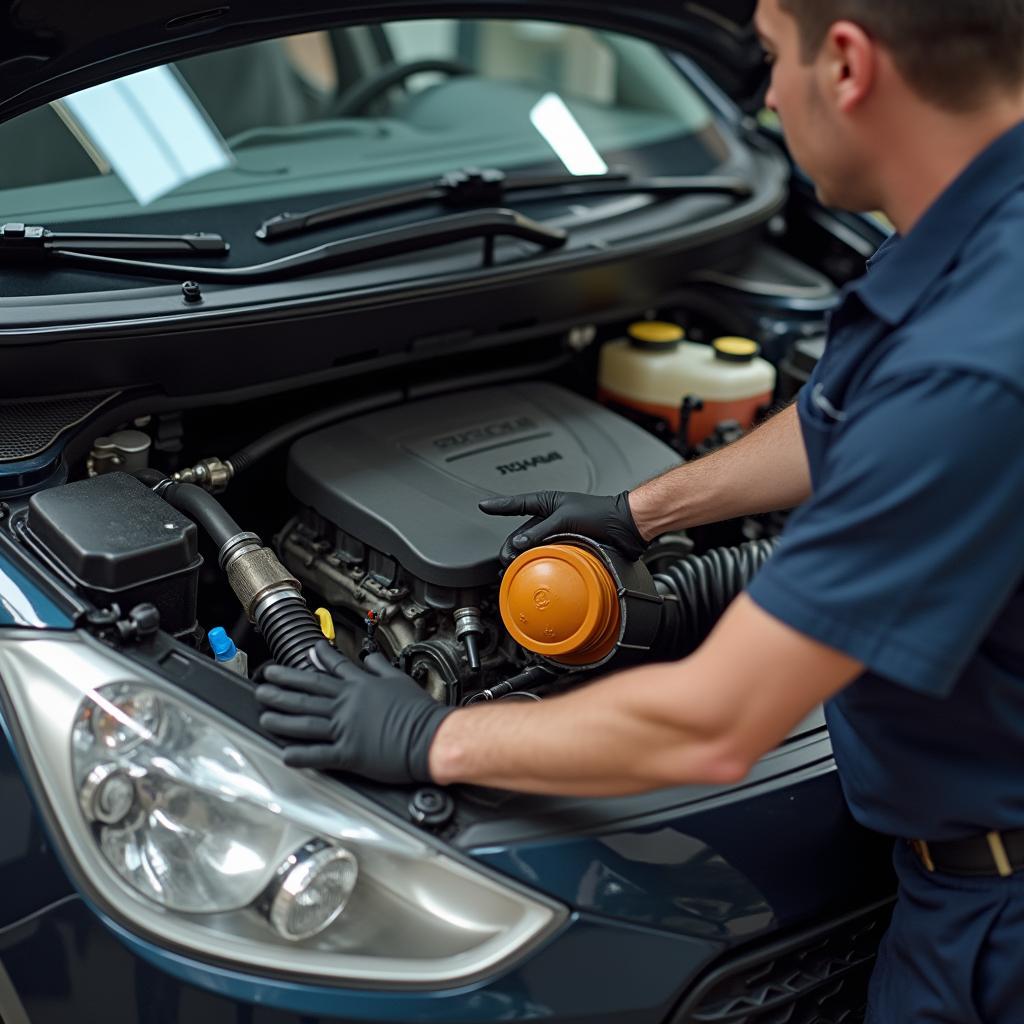Owning a Hyundai Grand i10 means enjoying a reliable and fuel-efficient car. However, like any vehicle, regular servicing is crucial to keep it running smoothly and prevent costly repairs down the line. Following the recommended Hyundai Grand I10 Car Servicing Schedule ensures optimal performance, safety, and longevity for your car.
This comprehensive guide delves into the specifics of the Hyundai Grand i10 car servicing schedule, covering everything from routine checks to major service milestones.
Understanding Your Hyundai Grand i10 Service Intervals
Hyundai typically recommends servicing your Grand i10 every 10,000 kilometers or 12 months, whichever comes first. However, depending on your driving conditions and habits, adjustments to this schedule might be necessary.
Factors influencing your individual service schedule:
- Driving conditions: Frequent city driving, stop-and-go traffic, and extreme weather can put more strain on your car, requiring more frequent servicing.
- Driving style: Aggressive acceleration and braking can lead to faster wear and tear on components.
- Fuel quality: Using low-quality fuel can impact engine performance and necessitate earlier servicing.
Hyundai Grand i10 Car Servicing Schedule Breakdown
While your owner’s manual provides the most accurate schedule for your specific model year, here’s a general overview of what to expect at different service intervals:
1. 10,000 km/12 Months Service (First Service)
The first service is crucial as it helps identify any manufacturing defects and ensures your car is running optimally after the initial break-in period.
Typical checks and services:
- Engine oil and filter change: Essential for lubrication and preventing engine wear.
- Visual inspection of brakes, belts, hoses, and tires: Identifying potential issues early on.
- Fluid level check and top-up (if necessary): Includes coolant, brake fluid, power steering fluid, and windshield washer fluid.
- Air filter cleaning/replacement: Ensures clean air for optimal combustion.
- Scanning for diagnostic trouble codes (DTCs): Identifies any underlying electronic issues.
2. 20,000 km/24 Months Service
This service focuses on preventative maintenance and addresses components that typically wear down with regular use.
Typical checks and services:
- Repeat of 10,000 km service checks and services
- Brake pad inspection and potential replacement: Worn brake pads compromise stopping distance and safety.
- Spark plug inspection and potential replacement: Worn spark plugs can impact fuel economy and engine performance.
- Cabin air filter replacement: Ensures clean air inside the cabin, particularly important for allergy sufferers.
- Battery health check: Identifies potential battery issues and ensures optimal starting power.
3. 40,000 km/48 Months Service
This service delves deeper into your car’s systems and addresses more complex components.
Typical checks and services:
- Repeat of 20,000 km service checks and services
- Fuel filter replacement: Ensures clean fuel delivery to the engine, optimizing performance and fuel economy.
- Transmission fluid inspection and potential replacement: Crucial for smooth gear shifting and preventing transmission damage.
- Coolant flush and refill: Prevents corrosion and maintains optimal engine temperature.
- Suspension and steering components inspection: Identifies any wear and tear in the suspension system, ensuring a comfortable and controlled ride.
4. 60,000 km/72 Months Service and Beyond
The 60,000 km service is a major service milestone and involves comprehensive checks and potential replacements.
Typical checks and services:
- Repeat of 40,000 km service checks and services
- Timing belt/chain inspection and potential replacement: Crucial for engine timing and preventing catastrophic engine damage if broken.
- Drive belt inspection and potential replacement: Ensures proper functioning of alternator, power steering, and air conditioning.
- Comprehensive inspection of all systems: Includes a thorough check of the engine, transmission, brakes, suspension, steering, electrical system, and exhaust system.
Beyond the 60,000 km mark, your Hyundai Grand i10 will require similar service intervals, with specific checks and replacements dictated by your car’s age and mileage.
Importance of Adhering to the Service Schedule
Sticking to the recommended Hyundai Grand i10 car servicing schedule offers numerous benefits:
- Increased lifespan: Regular maintenance prevents premature wear and tear, extending your car’s lifespan.
- Improved fuel efficiency: Clean filters, fresh fluids, and a well-tuned engine contribute to optimal fuel economy.
- Enhanced safety: Properly maintained brakes, tires, and suspension components are crucial for safe driving.
- Higher resale value: A well-maintained car with a documented service history commands a higher resale value.
- Warranty preservation: Adhering to the schedule ensures you remain eligible for warranty coverage.
Finding a Reliable Hyundai Service Center
While it might be tempting to opt for the cheapest service option, entrusting your Hyundai Grand i10 to a reputable and experienced service center is paramount.
Look for a service center that:
- Specializes in Hyundai vehicles: Ensures technicians are familiar with the intricacies of your specific model.
- Uses genuine Hyundai parts: Guarantees optimal performance and longevity.
- Provides transparent pricing and detailed service reports.
- Has positive customer reviews and testimonials.
Conclusion
Regular servicing is an investment in the longevity, performance, and safety of your Hyundai Grand i10. By adhering to the recommended car servicing schedule and choosing a reputable service center, you can enjoy many miles of worry-free driving.
Remember, consult your owner’s manual for the most accurate service schedule for your specific model year and always address any concerns or unusual noises promptly.
